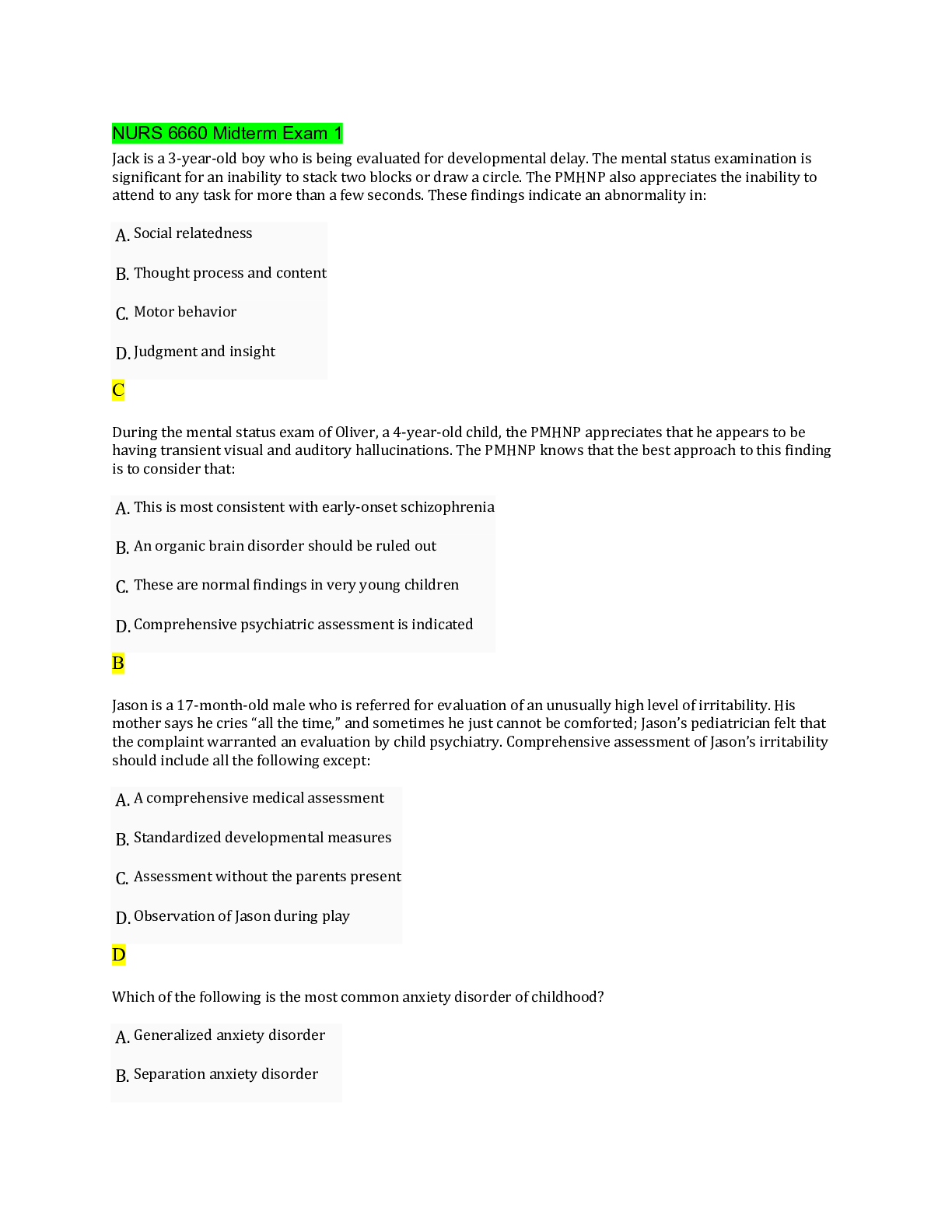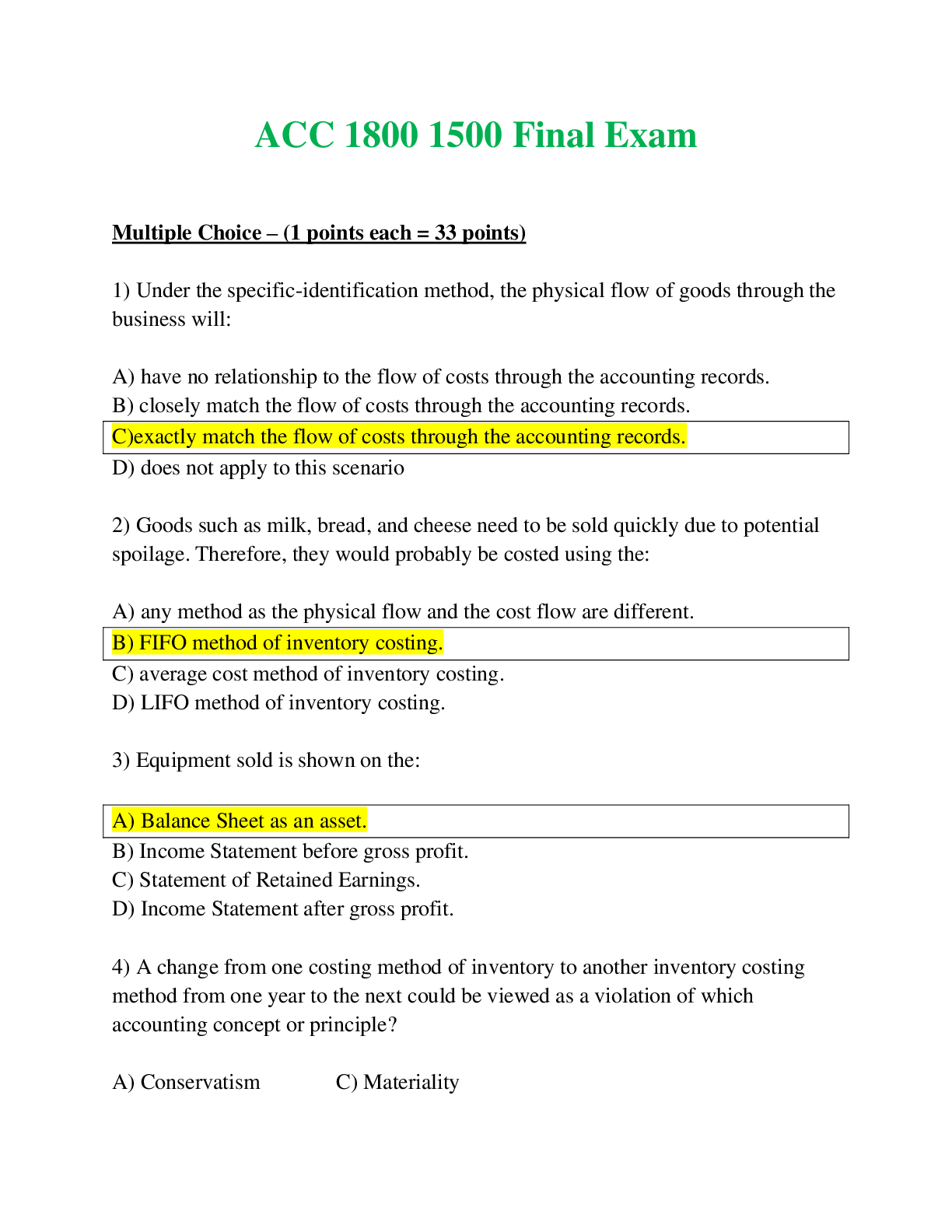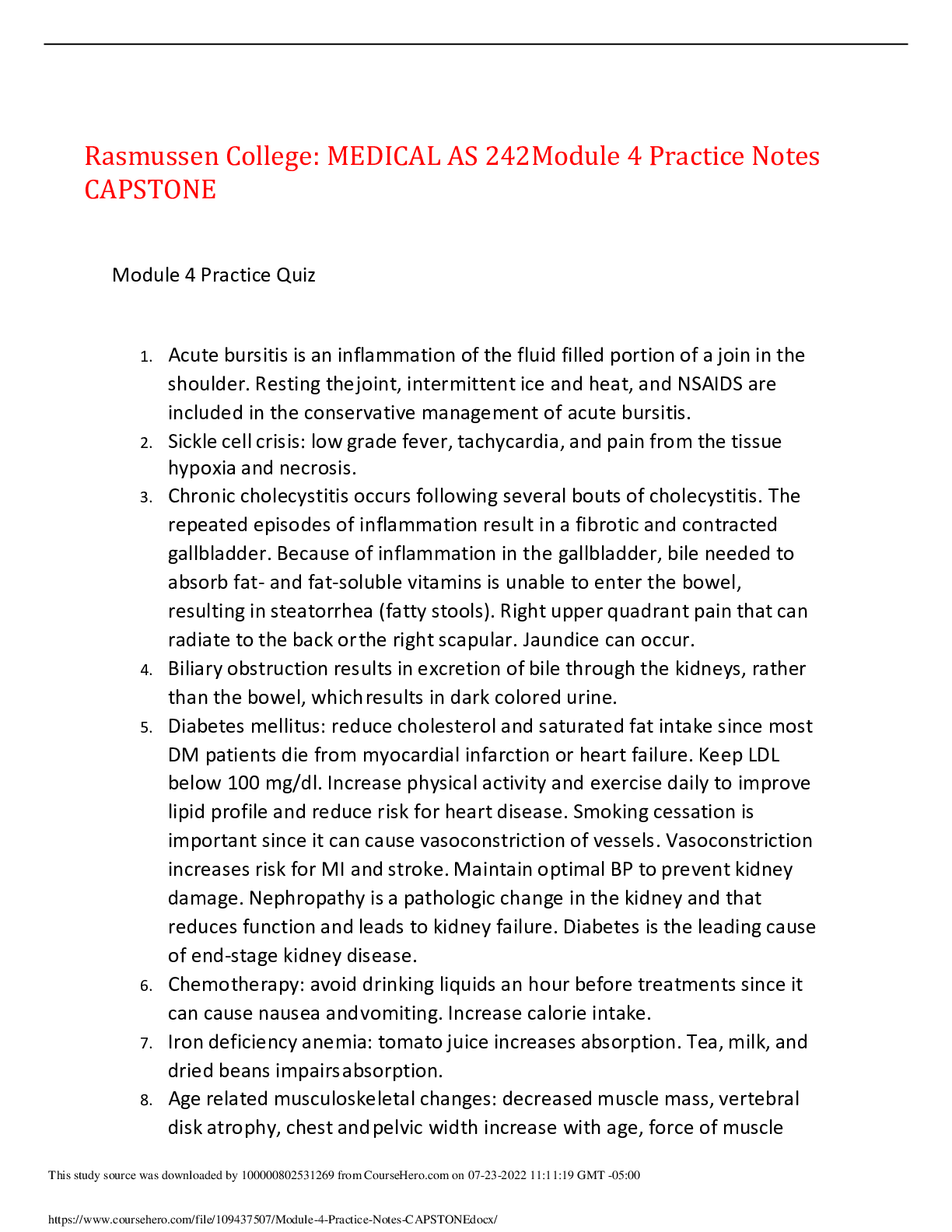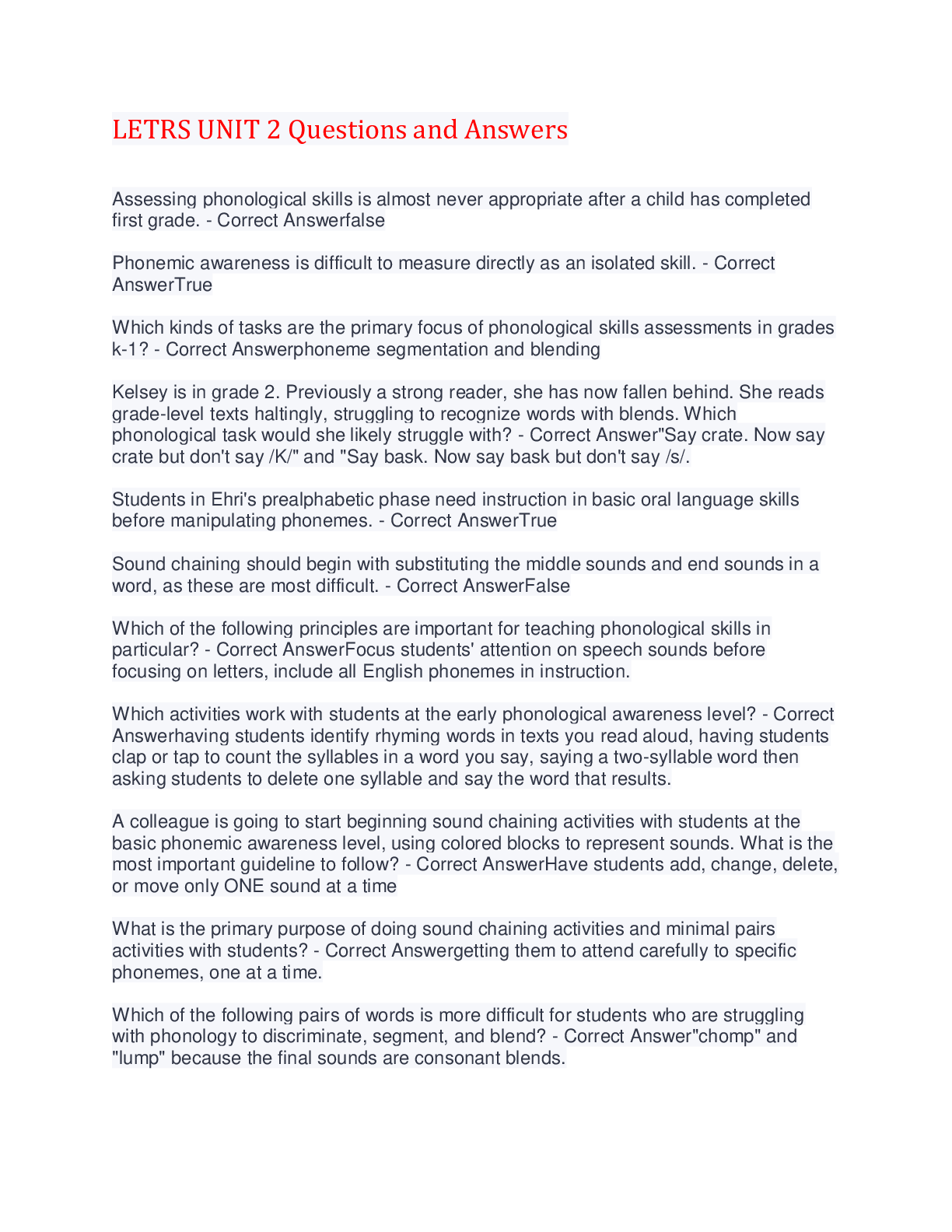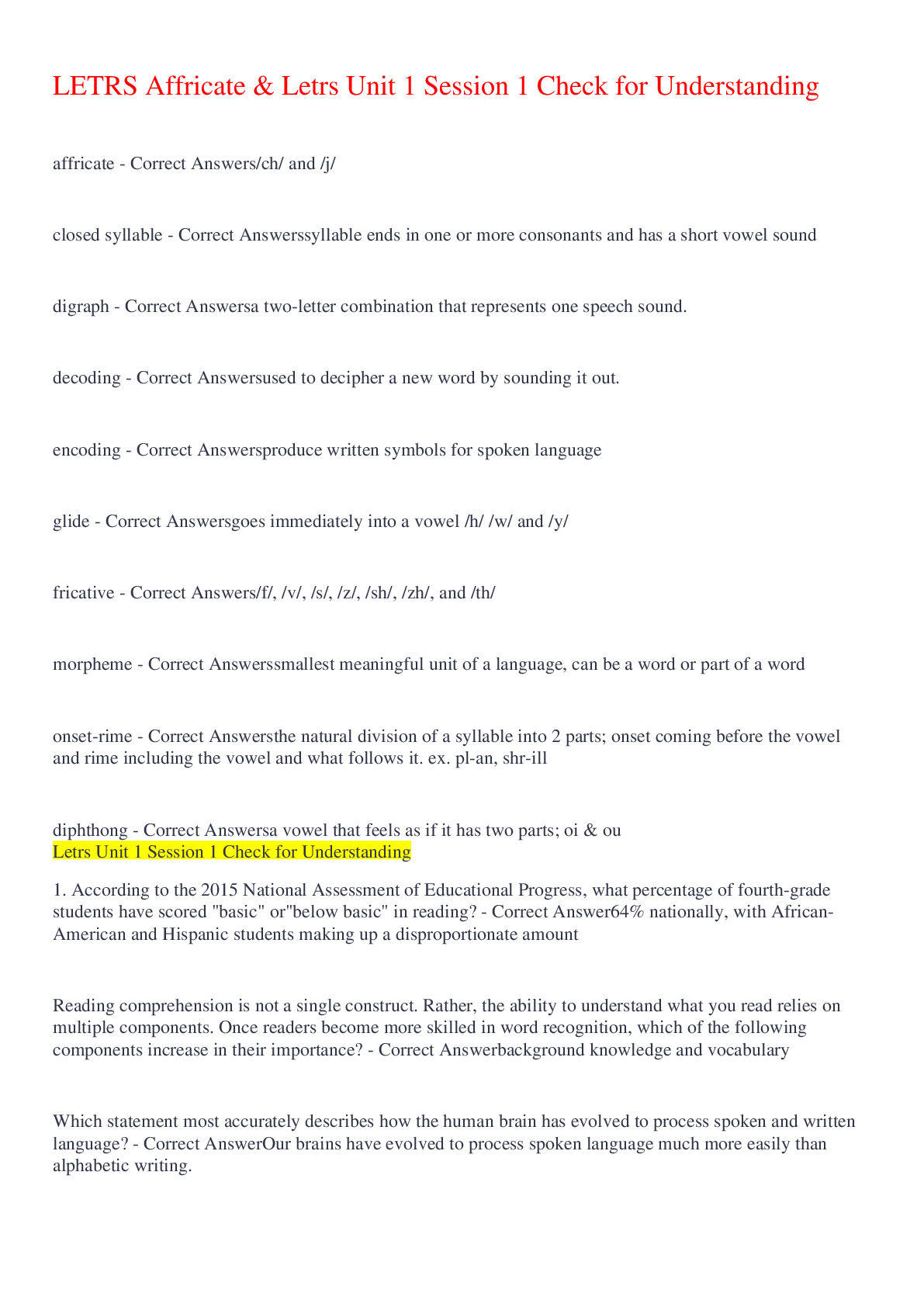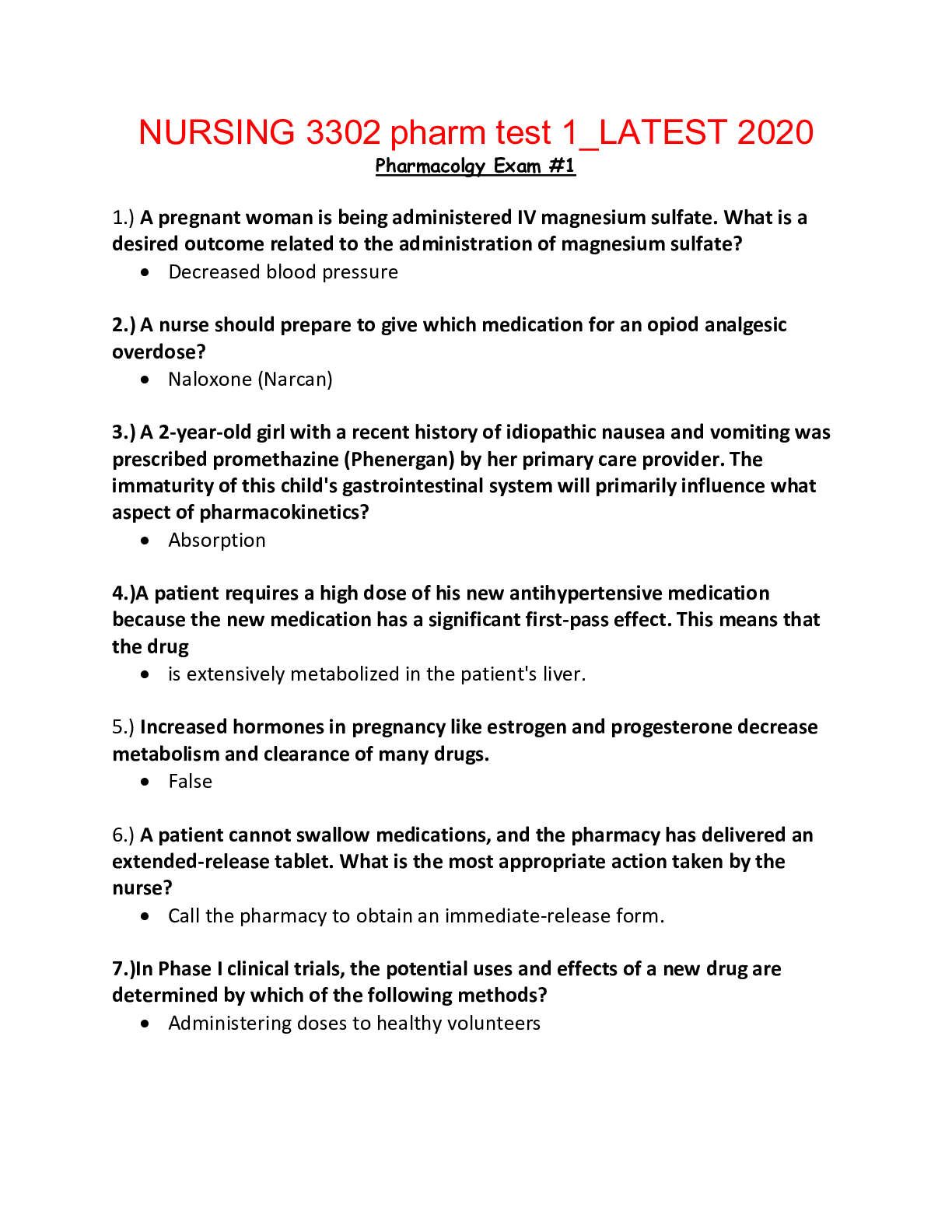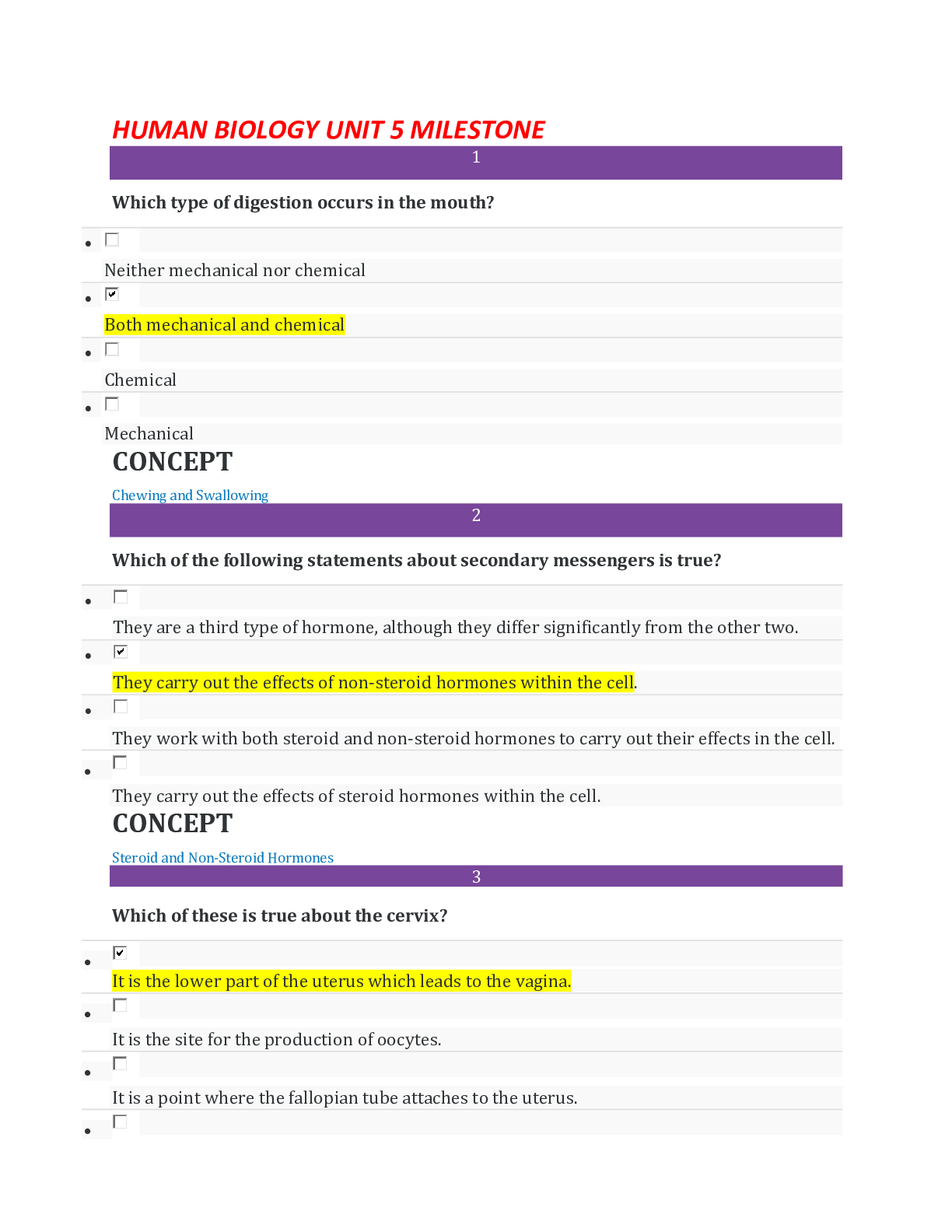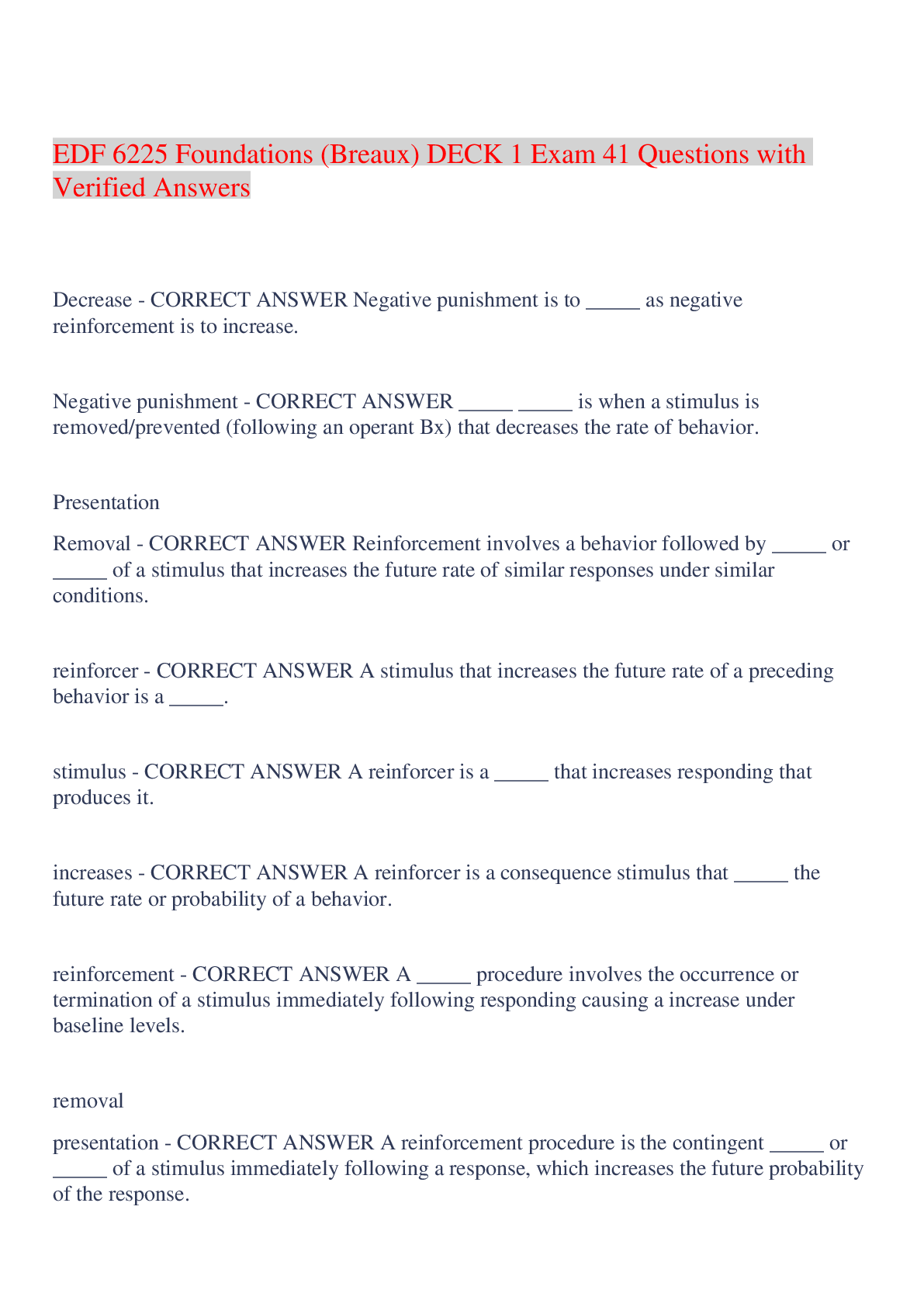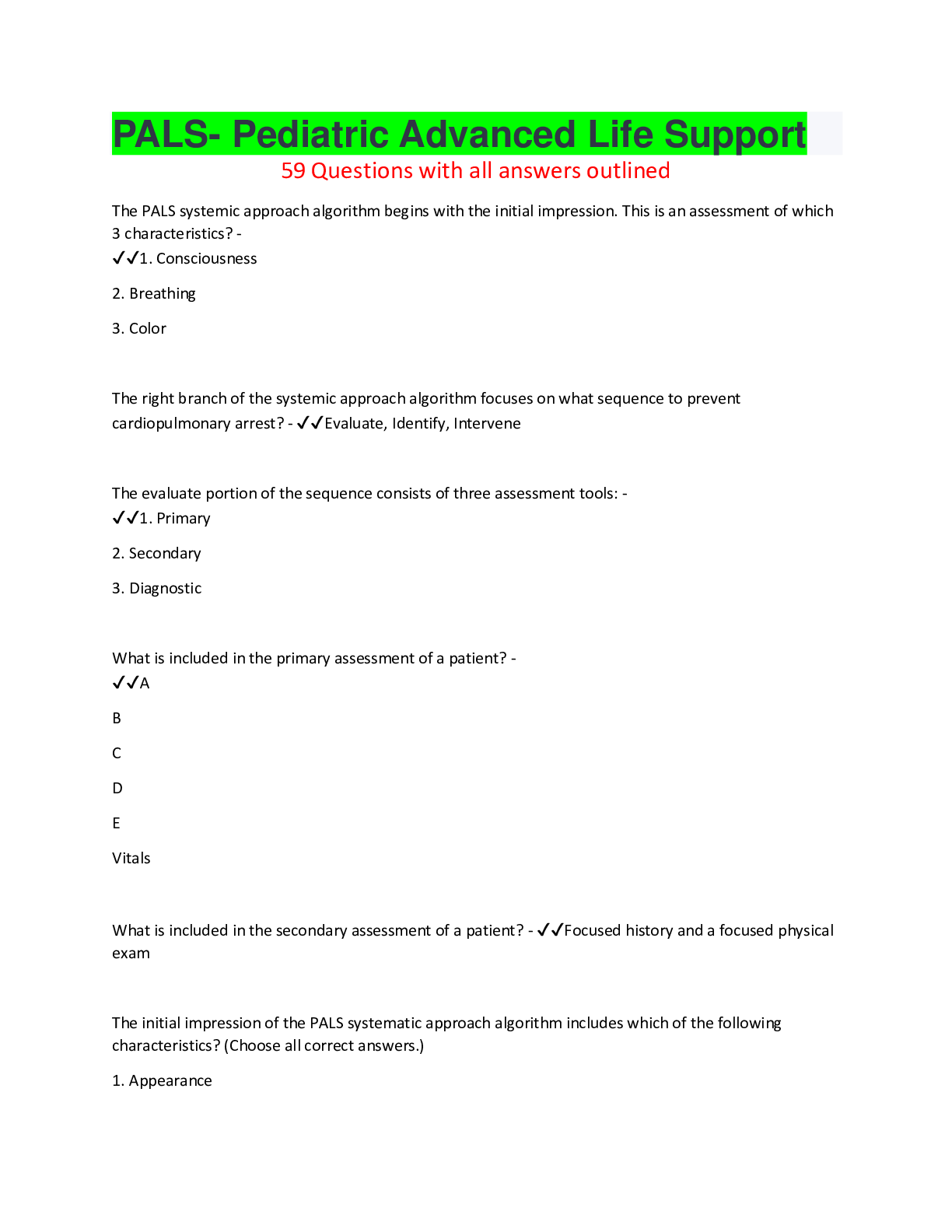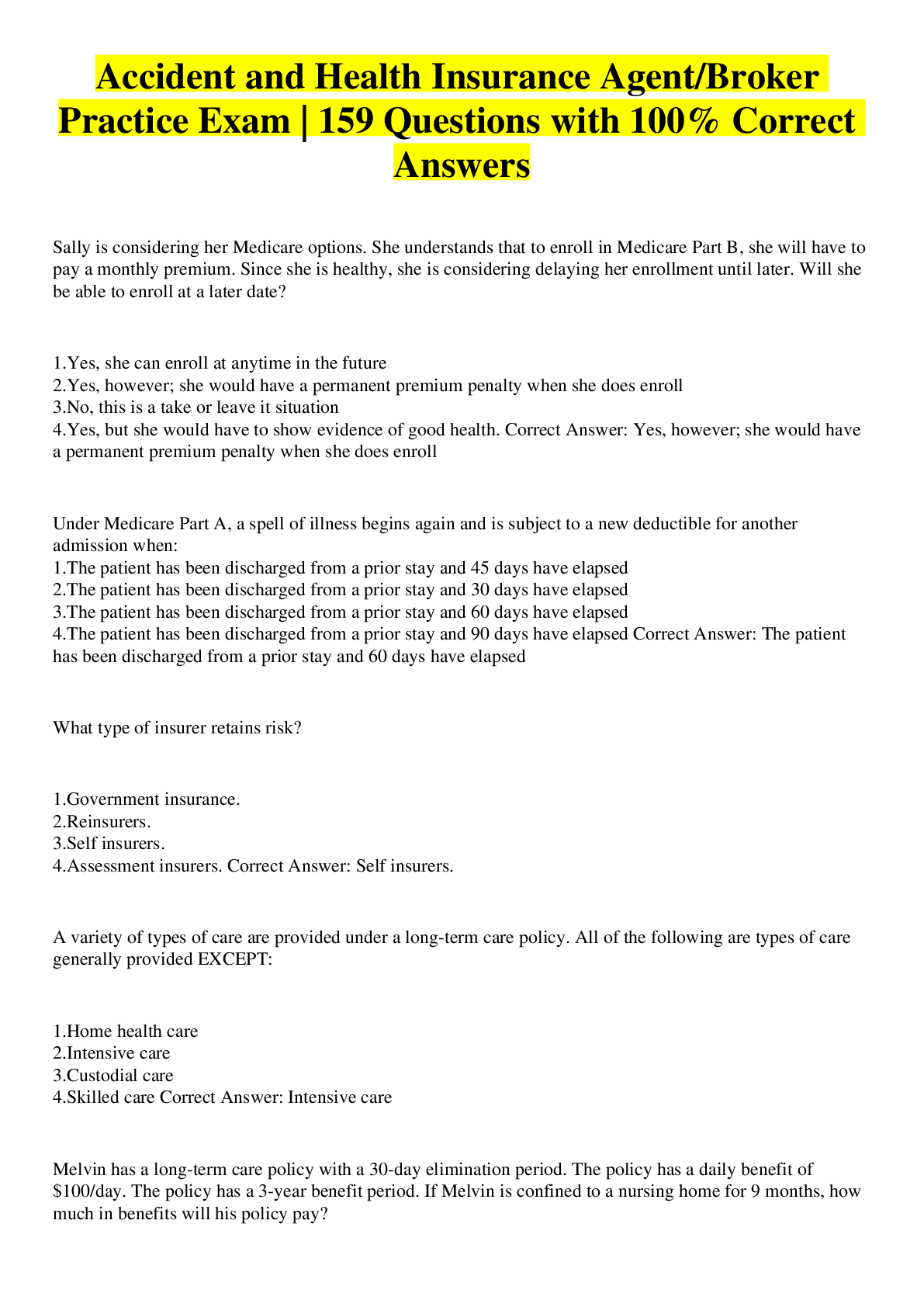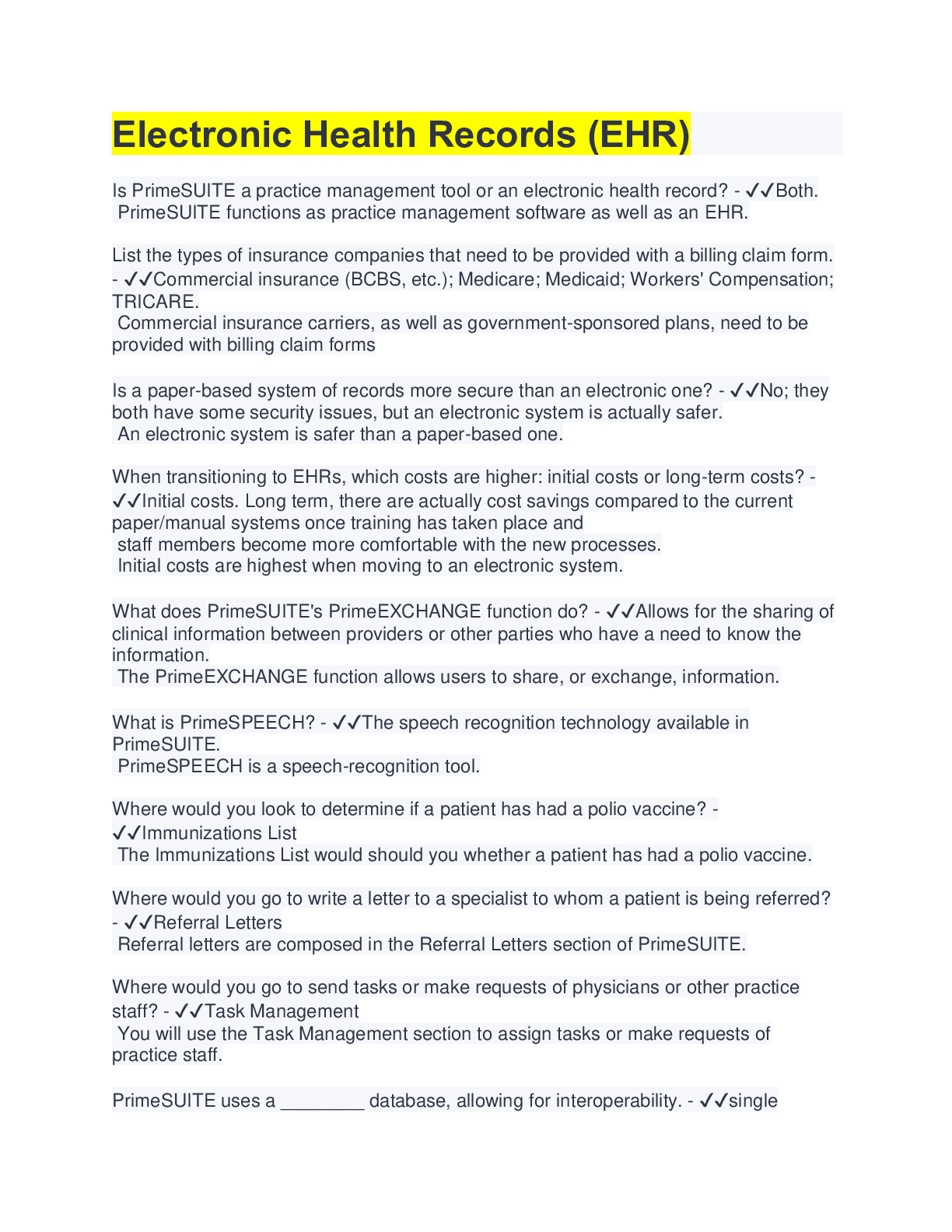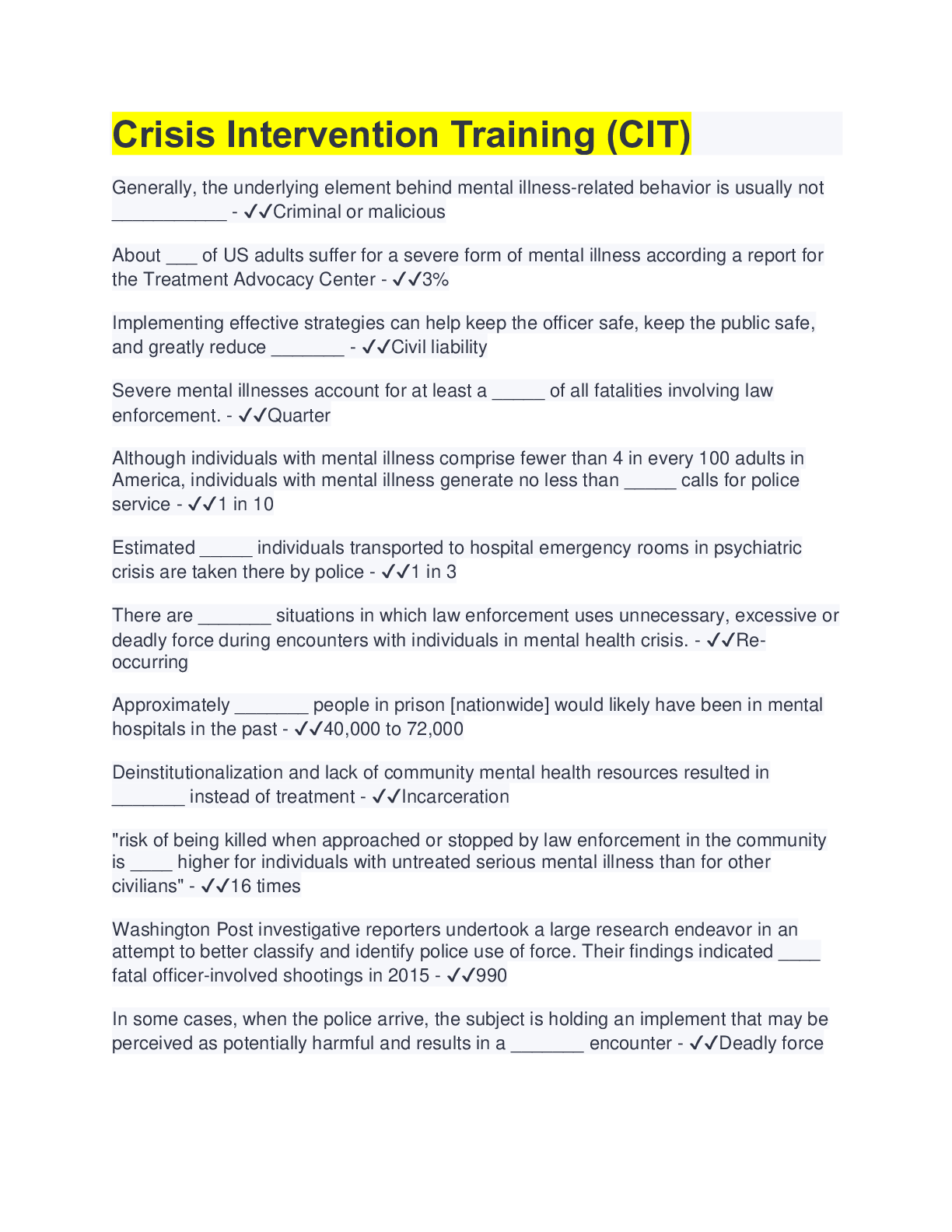Health Care > EXAM > NFPA 10 fire extinguishers Exam 59 Questions with Verified Answers,100% CORRECT (All)
NFPA 10 fire extinguishers Exam 59 Questions with Verified Answers,100% CORRECT
Document Content and Description Below
NFPA 10 fire extinguishers Exam 59 Questions with Verified Answers Obsolete fire extinguishers - CORRECT ANSWER 1. soda acid 2. chemical foam(excluding film forming agents) 3. vaporizing liquid ... 4. cartridge-operated water 5. cartridge-operated loaded stream 6. copper or brass shell (excluding pump tanks) joined by soft solder or rivets 7. carbon dioxide extinguishers with metal horns 8. solid charge-type afff extinguishers (paper cartridge) 9. pressurized water fire extinguishers manufactured prior to 1971 10. any extinguisher that needs to be inverted to operate 11. any stored pressure extinguisher manufactured prior to 1955 12. any extinguishers with 4b, 6b, 8b, 12b, and 16b fire ratings 13. stored-pressure water extinguishers with fiber glass shells (pre-1976) Dry Chemical extinguishers shall be removed from service - CORRECT ANSWER what happens to dry chemical stored-pressure extinguishers manufactured prior to october 1984 at the next 6-year maintenance interval or hydrotest? Determines the selection of the type of fire extinguishers - CORRECT ANSWER 1. type of fire most likely to occur 2. size of fire most likely to occur 3. hazards in the area where the fire is most likely to occur 4. energized electrical equipment in the vicinity of the fire 5. ambient temperature conditions Class A - CORRECT ANSWER Fires in ordinary combustible materials, such as wood, cloth, paper, rubber, and many plastics. Class B - CORRECT ANSWER Fires in flammable liquids, combustible liquids, petroleum greases, tars, oils, oil-based paints, solvents, lacquers, alcohols, and flammable gases. Class C - CORRECT ANSWER fires that involve energized electrical equipment. Class D - CORRECT ANSWER Fires in combustible metals, such as magnesium, titanium, zirconium, sodium, lithium, and potassium. Class K - CORRECT ANSWER Fires in cooking appliances that involve combustible cooking media (vegetable or animal oils and fats). Wheeled Fire extinguishers - CORRECT ANSWER What extinguisher shall be considered when the following fire risk has shown the following? 1. High hazard areas are present. 2. limited available personnel are present, thereby requiring an extinguisher that haas the following features: a. high agent flow rate b increased agent stream range c increased agent capacity Extended wand-type discharge devices - CORRECT ANSWER What shall class k fire extinguishers manufactured after january 1, 2002 not be equipped with? Areas containing oxidizers such as pool chemicals - CORRECT ANSWER What area can only contain water-type extinguishers? Portable fire extinguishers other than wheeled fire extinguishers - CORRECT ANSWER Installation for which extinguishers? 1. securely on a hanger intended for the extinguisher 2. in at the bracket supplied by the extinguisher manufacturer 3. in a listed bracket approved for such purpose 4. in cabinets or wall recesses 5 feet - CORRECT ANSWER Maximum Installation height for fire extinguishers having a gross weight not exceeding 40lb shall be installed above floor? 3 1/2 feet - CORRECT ANSWER Maximum installation height for fire extinguishers having a gross weight greater than 40 lb shall be installed above floor? 4 inches - CORRECT ANSWER What is the minimum clearance between the bottom of the extinguisher and the floor? -40 degrees - CORRECT ANSWER At what temperatures should antifreeze be used in combination with fire extinguishers? Calcium chloride - CORRECT ANSWER What should not be used in stainless steel fire extinguishers? 75 feet - CORRECT ANSWER Maximum travel distance for Class A hazards? 30 to 50 feet - CORRECT ANSWER Maximum travel distance for Class B hazards? Located where energized electrical equipment can be encountered - CORRECT ANSWER Maximum travel distance for Class C hazards? 75 feet - CORRECT ANSWER Maximum travel distance for class D fires? 30 feet - CORRECT ANSWER Maximum travel distance for Class K fires? Every 30 days - CORRECT ANSWER How often should fire extinguishers be inspected? 1 year - CORRECT ANSWER Maintenance involving internal examination for stored-pressure loaded stream? 1 year - CORRECT ANSWER Maintenance involving internal examination for pump tank water and pump tank calcium chloride-based? 1 year - CORRECT ANSWER Maintenance involving internal examination for dry chemical, cartridge- and cylinder operated, with mild steel shells? 1 year - CORRECT ANSWER Maintenance involving internal examination for dry powder, cartridge and cylinder operated, with mild steel shells? 1 year - CORRECT ANSWER Maintenance involving internal examination for wetting agent? 5 years - CORRECT ANSWER Maintenance involving internal examination for stored-pressure water? 3 years - CORRECT ANSWER Maintenance involving internal examination for AFFF (aqueous film-forming foam) and FFFP (film-forming fluoroprotein foam) and when is the liquid replaced? 5 years - CORRECT ANSWER Maintenance involving internal examination for stored pressure dry chemical, with stainless steel shells? 5 years - CORRECT ANSWER Maintenance involving internal examination for carbon dioxide? 5 years - CORRECT ANSWER Maintenance involving internal examination for wet chemical? 6 years - CORRECT ANSWER Maintenance involving internal examination for dry chemical stored pressure, with mild steel shells, brazed brass shells, and aluminum shells? 6 years - CORRECT ANSWER Maintenance involving internal examination for halogenated agents? 6 years - CORRECT ANSWER Maintenance involving internal examination for dry powder, stored pressure, with mild steel shells? 1 year - CORRECT ANSWER How often should carbon dioxide hose assemblies go through a conductivity test? 1 year - CORRECT ANSWER How often should pressure regulators for the outlet static pressure and flow rate for wheeled fire type extinguishers be tested? 5 years - CORRECT ANSWER Hydrostatic test intervals for stored pressure water, water mist, loaded stream, and/or antifreeze? 5 years - CORRECT ANSWER Hydrostatic test internvals for wetting agent? 5 years - CORRECT ANSWER Hydrostatic test intervals for AFFF (aqueous film forming foam) and FFFP (film forming fluoroprotein foam? 5 years - CORRECT ANSWER Hydrostatic test intervals for Dry chemical with stainless steel shells? 5 years - CORRECT ANSWER Hydrostatic test intervals for carbon dioxide? 5 years - CORRECT ANSWER Hydrostatic test intervals for wet chemical? 12 years - CORRECT ANSWER Hydrostatic test intervals for dry chemical, stored pressure, with mild steel shells, brazed brass shells or aluminum shells? 12 years - CORRECT ANSWER Hydrostatic test intervals for dry chemical, cartridge- or cylinder operated, with mild steel shells? 12 years - CORRECT ANSWER Hydrostatic test intervals for halogenated agents? 12 years - CORRECT ANSWER Hydrostatic test intervals for Dry powder, stored pressure, cartridge or cylinder operated, with mild steel shells? Light (low) - CORRECT ANSWER What hazard occupancies include the following buildings or rooms occupied as offices, class rooms, churches, assembly halls, guest room areas of hotels or motels and so forth. This classification anticipates that the majority of content items are either non combustible or arranged that a fire is not likely to spread rapidly. Small amounts of class b flammables used for duplicating machines, art departments, and so forth, are included, provided that they are kept in closed containers and safely stored. Ordinary (moderate) - CORRECT ANSWER What hazard occupancies could consist of dining areas, mercantile shops and allied storage, light manufacturing, research operations, auto showrooms, parking garages, workshop or support service areas of light (low) hazard occupancies, and warehouses containing class I or Class II commodities as defined by nfpa 13, standard for the installation of sprinkler systems. A class I commodity is defined by nfpa 13 as a noncombustible product that meets one of the following criteria: 1. is placed directly on wooden pallets 2. is placed in single layer corrugated cartons, with or without single thickness cardboard dividers, with or without pallets 3. is shrink wrapped or paper wrapped as a unit load, with or without pallets A class II commodity is defined by nfpa 13 as a noncombustible product that is in slatted wooden crates, solid wood boxes, multiple layered corrugated cartons or equivalent combustible packaging material, with or without pallets Extra (high) - CORRECT ANSWER Hazard occupancies could consist of woodworking; vehicle repair, aircraft and boat servicing; cooking areas; individual product display showrooms; product convention center displays; and storage and manufacturing processes such as painting, dipping, and coating, including flammable liquid handling. Also included is warehousing or in process storage of other than class I and class II commodities. Distribution - CORRECT ANSWER What does the following affect portable fire extinguishers? 1. area and arrangement of the building occupancy conditions 2. severity of the hazard 3. anticipated classes of fire 4. other protective systems or devices 5. distances to be traveled to reach fire extinguishers 6. anticipated rate of fire spread 7. intensity and rate of heat development 8. smoke contributed by the burning materials 9. accessibility of a fire to close approach with portable fire extinguishers carbon dioxide - CORRECT ANSWER a colorless, odorless, electrically non conductive inert gas that is a suitable medium for extinguishing class B and class C fires dry chemical - CORRECT ANSWER a powder composed of very small particles, usually sodium bicarbonate, potassium bicarbonate, or ammonium phosphate based with added particulate material supplemented by special treatment to provide resistance to packing, resistance to moisture absorption ( caking) and the proper flow capabilities. wet chemical - CORRECT ANSWER normally an aqueous solution of organic or inorganic salts or a combination there of that forms an extinguishing agent. clean agent - CORRECT ANSWER electrically non conducting, volatile, or gaseous fire extinguishant that does not leave a residue upon evaporation high pressure cylinder - CORRECT ANSWER cylinders containing nitrogen, compressed air, carbon dixide, or other gases at a pressure higher than 500 psi at 70 degrees F low pressure cylinder - CORRECT ANSWER cylinders containing fire extinguishing (medium), nitrogen, compressed air, or other compressed gases at a service pressure of 500 psi or lower at 70 degrees F dry powder - CORRECT ANSWER solid materials in powder or granular form designed to extinguish class D combustible metal fires by crusting, smothering, or heat transferring means. [Show More]
Last updated: 1 month ago
Preview 1 out of 7 pages

Buy this document to get the full access instantly
Instant Download Access after purchase
Buy NowInstant download
We Accept:

Reviews( 0 )
$10.00
Can't find what you want? Try our AI powered Search
Document information
Connected school, study & course
About the document
Uploaded On
Dec 09, 2023
Number of pages
7
Written in
Additional information
This document has been written for:
Uploaded
Dec 09, 2023
Downloads
0
Views
174


